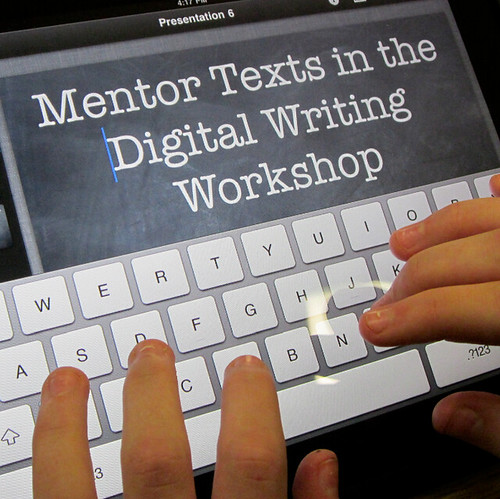
(Note: this blog post and a few more this week is part of a series around mentor texts and digital composition. The blog posts are all being collected over at Mentor Texts in the Digital Writing Workshop)
One of the most difficult parts of using technology and digital media with students remains with how best to assess a piece of student work. Given that there are not enough mentor texts with which we can use to showcase exemplar projects (see my post about teachers needing to be creators), we need to engage students more in the development of assessment tools. I’ll be honest: this guided collaborative thinking between teacher and students takes time and I owe a lot of work I do around to a fellow Western Massachusetts Writing Project friend, Mary Farrin, whose workshop on rubric development opened my eyes.
The way this works is that the teacher presents a piece of work — in this case, a digital text — and together, the students and the teacher identify areas that should be part of a final assessment. The broad topics then get broken down into categories. The role of the teacher is to guide the discussion and focus the students on elements of importance. As Mary used to say, it is the process of developing the tool that gets students focused on meeting our expectations for their best work. After the brainstorming by students, the teacher then takes those ideas and develops a scoring tool that makes sense for a project. The students feel as if their voices are part of the mix.
Last year, I used this process for a Digital Poster Project that was a companion piece to an environmental essay project. We were using Glogster, which is a great site with many tools and possibilities but it is also is a site that has so many tools that some students get caught up in the flash and forget the content. So, we worked together on developing a rubric.
First,we examined a few Glog projects from the classes from the year before. We were just “looking” at elements that seemed worth “noticing” and discussing why something like design might play a role in the way a teacher might assess a digital poster.
Next, I created my own Glog about the topic that I was writing about (just ahead of them) around Fuel Cell Technology.
Finally, I pulled up a blank rubric and together, we talked about what someone would be looking at when they looked at my glog. We decided that the four main areas would be: scientific content, design elements, and multimedia. (Later, I added in the usual Grammar/Mechanics, which they conveniently left out). We then began to break down each category with the question: what would a writer need to do to meet our expectations? This where I again guided discussions. (Depending on the project, you might need more than just “meets expectations” and “does not meet expectations” but this was part of a larger project and these designations met our needs. I could have also used the input from students at this level, and then extended out the rest of the rubric myself along these same lines.)
Here is what we came up with:
Environmental Project Brainstorm Rubric
And then, they were off on their projects, with our collaborative rubric on the whiteboard while they were working. As I wandered and helped students, I kept referring conversations back to the board. (“Does that dancing penguin really help your design?”) The result was a pretty strong crop of projects, including this one about Rainforests:
Peace (in the assessment),
Kevin
PS: Also blogging about Mentor Texts and Digital Composition this week are:
Bill Bass, Technology Integration Specialist in Missouri and author of the upcoming ISTE book on Film Festivals tentatively titled, “Authentic Learning Through a Digital Lens” will be blogging on his blog MR. BASS ONLINE.
Katie DiCesare, a primary teacher in Dublin who runs an incredible writing workshop will be blogging at her blog, CREATIVE LITERACY.
Troy Hicks, author of THE DIGITAL WRITING WORKSHOP and BECAUSE DIGITAL WRITING MATTERS. He will be blogging at his site, DIGITAL WRITING, DIGITAL TEACHING.
Tony Keefer, an amazing 4th grade teacher in Dublin, Ohio will be blogging at at ATYCHIPHOBIA.
Franki Sibberson, a librarian of many skills and knowledge, and also from Ohio, over at A YEAR OF READING